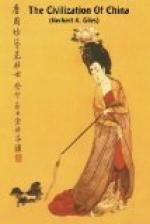The “pigtail,” or long plait of hair worn by all Chinamen, for the abolition of which many advanced reformers are now earnestly pleading, is an institution of comparatively modern date. It was imposed by the victorious Manchu-Tartars when they finally established their dynasty in 1644, not so much as a badge of conquest, still less of servitude, but as a means of obliterating, so far as possible, the most patent distinction between the two races, and of unifying the appearance, if not the aspirations, of the subjects of the Son of Heaven. This obligation was for some time strenuously resisted by the natives of Amoy, Swatow, and elsewhere in that neighbourhood. At length, when compelled to yield, it is said that they sullenly wound their queues round their heads and covered them with turbans, which are still worn by natives of those parts.
The peculiar custom of shaving the head in front, and allowing the hair to grow long behind, is said to have been adopted by the Manchus out of affectionate gratitude to the horse, an animal which has played an all-important part in the history and achievements of the race. This view is greatly reinforced by the cut of the modern official sleeves, which hang down, concealing the hands, and are shaped exactly like a pair of horse’s hoofs.
In many respects the Manchu conquerors left the Chinese to follow their own customs. No attempt was made to coerce Chinese women, who dress their hair in styles totally different from that of the Manchu women; there are, too, some tolerated differences between the dress of the Manchu and Chinese men, but these are such as readily escape notice. Neither was any attempt made in the opening years of the conquest to interfere with foot-binding by Chinese women; but in 1664 an edict was issued forbidding the practice. Readers may draw their own conclusions, when it is added that four years after the edict was withdrawn. Hopes are now widely and earnestly entertained that with the dawn of the new era, this cruel custom will become a thing of the past; it is, however, to be feared that those who have been urging on this desirable reform may be, like all reformers, a little too sanguine of immediate success, and that a comparatively long period will have to go by before the last traces of foot-binding disappear altogether. Meanwhile, it seems that the Government has taken the important step of refusing admission to the public schools of all girls whose feet are bound.
The disappearance of the queue is another thing altogether. It is not a native Chinese institution; there would be no violation of any cherished tradition of antiquity if it were once and for ever discarded. On the contrary, if the Chinese do not intend to follow the Japanese and take to foreign clothes, there might be a return to the old style of doing the hair. The former dress of the Japanese was one of the numerous items borrowed by them from China; it was indeed the national dress of the Chinese for some three hundred




